Citroen DS4 RHD 2013.5 1.G Owner's Manual
Manufacturer: CITROEN, Model Year: 2013.5, Model line: DS4 RHD, Model: Citroen DS4 RHD 2013.5 1.GPages: 400, PDF Size: 31.86 MB
Page 221 of 400
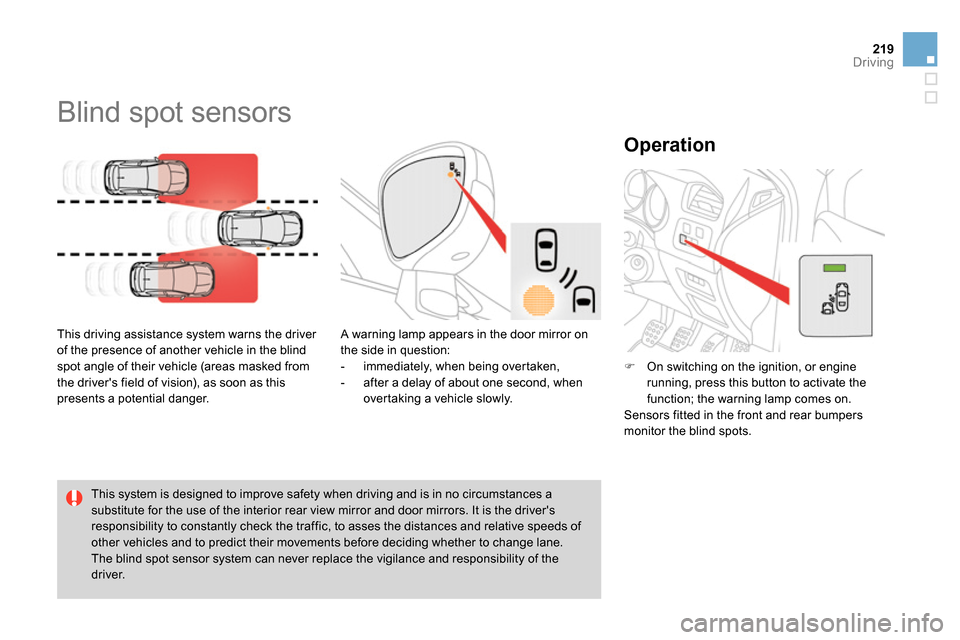
219Driving
Blind spot sensors
This driving assistance system warns the driver
of the presence of another vehicle in the blind
spot angle of their vehicle (areas masked from
the driver's field of vision), as soon as this
presents a potential danger.
Operation
This system is designed to improve safety when driving and is in no circumstances a
substitute for the use of the interior rear view mirror and door mirrors. It is the driver's
responsibility to constantly check the traffic, to asses the distances and relative speeds of
other vehicles and to predict their movements before deciding whether to change lane.
The blind spot sensor system can never replace the vigilance and responsibility of the
driver.
On switching on the ignition, or engine
running, press this button to activate the
function; the warning lamp comes on.
Sensors fitted in the front and rear bumpers
monitor the blind spots. A warning lamp appears in the door mirror on
the side in question:
- immediately, when being overtaken,
- after a delay of about one second, when
overtaking a vehicle slowly.
Page 222 of 400
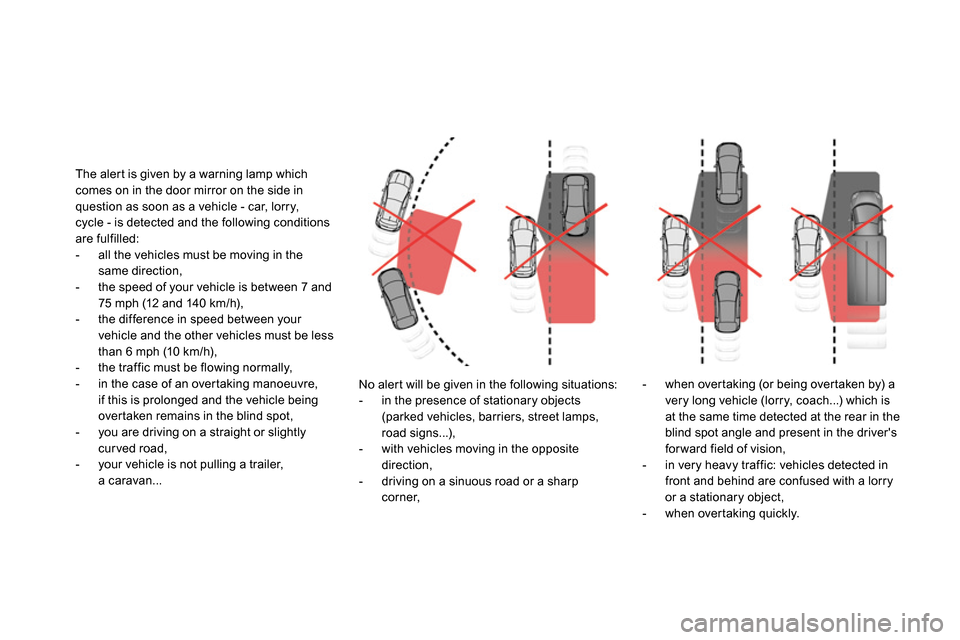
No alert will be given in the following situations:
- in the presence of stationary objects
(parked vehicles, barriers, street lamps,
road signs...),
- with vehicles moving in the opposite
direction,
- driving on a sinuous road or a sharp
corner, The alert is given by a warning lamp which
comes on in the door mirror on the side in
question as soon as a vehicle - car, lorry,
cycle - is detected and the following conditions
are fulfilled:
- all the vehicles must be moving in the
same direction,
- the speed of your vehicle is between 7 and
75 mph (12 and 140 km/h),
- the difference in speed between your
vehicle and the other vehicles must be less
than 6 mph (10 km/h),
- the traffic must be flowing normally,
- in the case of an overtaking manoeuvre,
if this is prolonged and the vehicle being
overtaken remains in the blind spot,
- you are driving on a straight or slightly
cur ved road,
- your vehicle is not pulling a trailer,
a caravan...
- when over taking (or being over taken by) a
very long vehicle (lorry, coach...) which is
at the same time detected at the rear in the
blind spot angle and present in the driver's
for ward field of vision,
- in very heavy traffic: vehicles detected in
front and behind are confused with a lorry
or a stationary object,
- when overtaking quickly.
Page 223 of 400

221Driving
Operating fault
In the event of a fault, the warning lamp in the
button flashes then goes off.
Have it checked by a CITROËN dealer or a
qualified workshop.
The system may suffer temporary
inter ference in certain weather
conditions (rain, hail...).
In particular, driving on a wet sur face
or moving from a dry area to a wet area
can cause false alerts (for example, the
presence of a fog of water droplets in
the blind spot angle is interpreted as a
vehicle).
In bad or wintry weather, ensure that
the sensors are not covered by mud,
ice or snow.
Take care not to cover the warning
zone in the door mirrors or the
detection zones on the front and rear
bumpers with adhesive labels or other
objects; they may hamper the correct
operation of the system.
To deactivate the system, press this button
again; the warning lamp goes off.
The state of the system remains in memory on
switching off the ignition.
The system is automatically
deactivated when towing with a towbar
approved by CITROËN.
Page 224 of 400
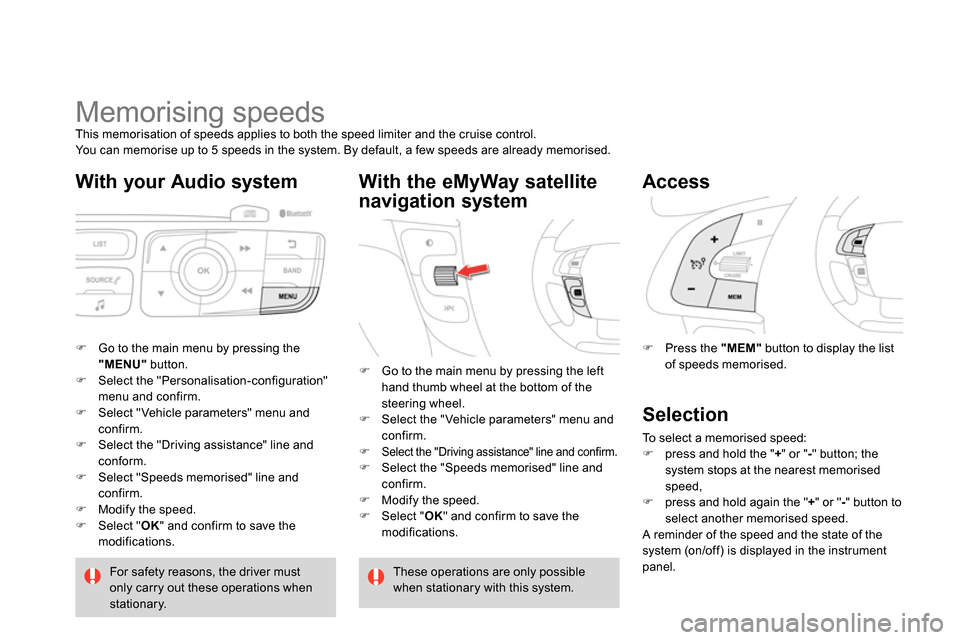
Memorising speeds
This memorisation of speeds applies to both the speed limiter and the cruise control.
You can memorise up to 5 speeds in the system. By default, a few speeds are already memorised.
With your Audio system
Go to the main menu by pressing the
"MENU"
button.
Select the "Personalisation-configuration"
menu and confirm.
Select " Vehicle parameters" menu and
confirm.
Select the "Driving assistance" line and
conform.
Select "Speeds memorised" line and
confirm.
Modify the speed.
Select " OK
" and confirm to save the
modifications.
With the eMyWay satellite
navigation system
Press the "MEM"
button to display the list
of speeds memorised.
Access
For safety reasons, the driver must
only carry out these operations when
stationary.
Go to the main menu by pressing the left
hand thumb wheel at the bottom of the
steering wheel.
Select the " Vehicle parameters" menu and
confirm.
Select the "Driving assistance" line and confirm.
Select the "Speeds memorised" line and
confirm.
Modify the speed.
Select " OK
" and confirm to save the
modifications.
These operations are only possible
when stationary with this system.
Selection
To select a memorised speed:
press and hold the " +
" or " -
" button; the
system stops at the nearest memorised
speed,
press and hold again the " +
" or " -
" button to
select another memorised speed.
A reminder of the speed and the state of the
system (on/off) is displayed in the instrument
panel.
Page 225 of 400
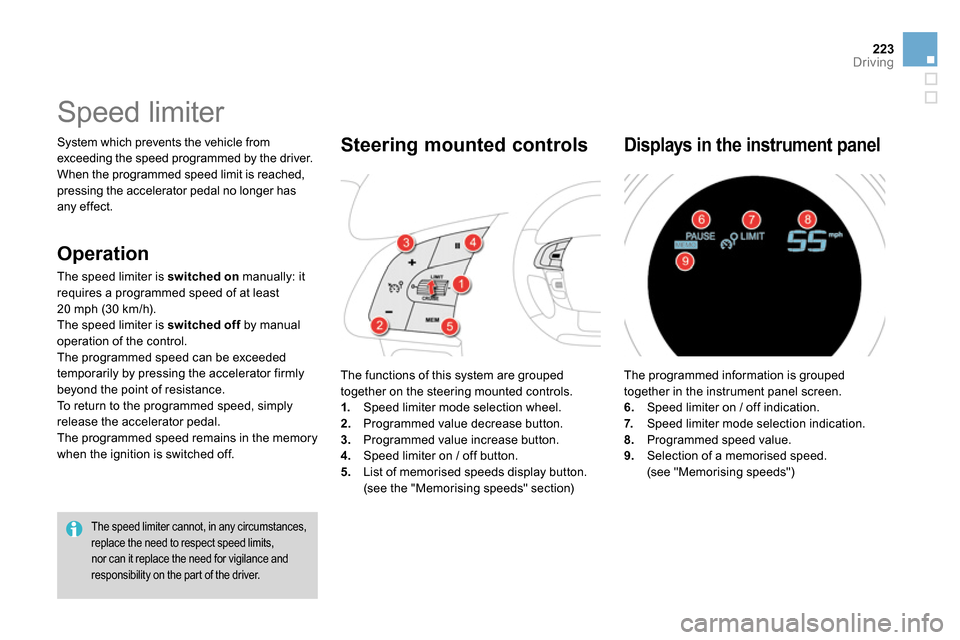
223Driving
System which prevents the vehicle from
exceeding the speed programmed by the driver.
When the programmed speed limit is reached,
pressing the accelerator pedal no longer has
any effect.
Speed limiter
The speed limiter cannot, in any circumstances,
replace the need to respect speed limits,
nor can it replace the need for vigilance and
responsibility on the part of the driver.
The functions of this system are grouped
together on the steering mounted controls.
1.
Speed limiter mode selection wheel.
2.
Programmed value decrease button.
3.
Programmed value increase button.
4.
Speed limiter on / off button.
5.
List of memorised speeds display button.
(see the "Memorising speeds" section)
Steering mounted controls
The programmed information is grouped
together in the instrument panel screen.
6.
Speed limiter on / off indication.
7.
Speed limiter mode selection indication.
8.
Programmed speed value.
9.
Selection of a memorised speed.
(see "Memorising speeds")
Displays in the instrument panel
Operation
The speed limiter is switched on
manually: it
requires a programmed speed of at least
20 mph (30 km/h).
The speed limiter is switched off
by manual
operation of the control.
The programmed speed can be exceeded
temporarily by pressing the accelerator firmly
beyond the point of resistance.
To return to the programmed speed, simply
release the accelerator pedal.
The programmed speed remains in the memory
when the ignition is switched off.
Page 226 of 400
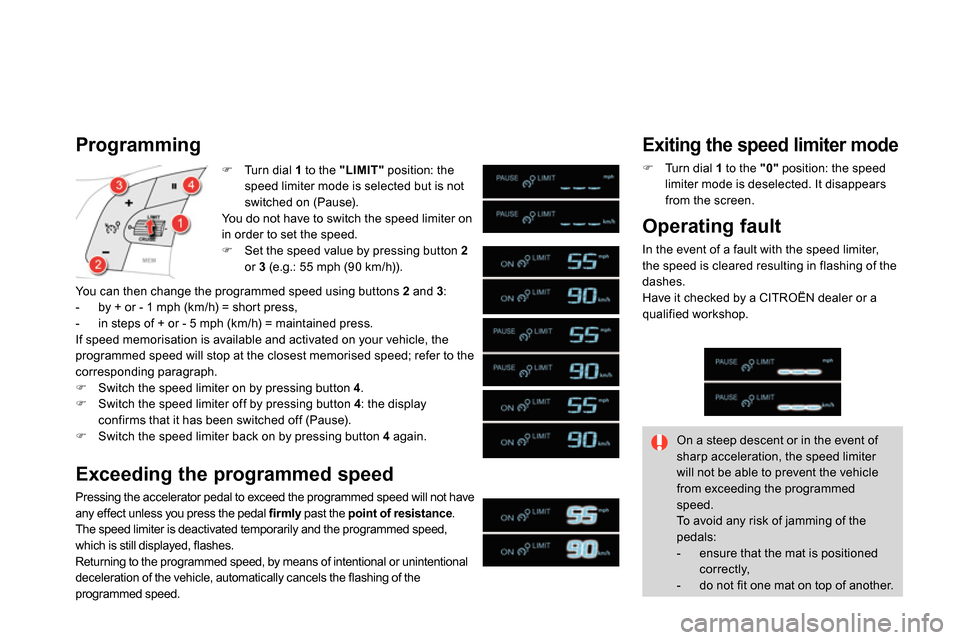
Turn dial 1
to the "LIMIT"
position: the
speed limiter mode is selected but is not
switched on (Pause).
You do not have to switch the speed limiter on
in order to set the speed.
Set the speed value by pressing button 2
or 3
(e.g.: 55 mph (90 km/h)).
Programming
You can then change the programmed speed using buttons 2
and 3
:
- by + or - 1 mph (km/h) = short press,
- in steps of + or - 5 mph (km/h) = maintained press.
If speed memorisation is available and activated on your vehicle, the
programmed speed will stop at the closest memorised speed; refer to the
corresponding paragraph.
Switch the speed limiter on by pressing button 4
.
Switch the speed limiter off by pressing button 4
: the display
confirms that it has been switched off (Pause).
Switch the speed limiter back on by pressing button 4
again.
Exceeding the programmed speed
Pressing the accelerator pedal to exceed the programmed speed will not have
any effect unless you press the pedal firmly
past the point of resistance
.
The speed limiter is deactivated temporarily and the programmed speed,
which is still displayed, flashes.
Returning to the programmed speed, by means of intentional or unintentional
deceleration of the vehicle, automatically cancels the flashing of the
programmed speed. On a steep descent or in the event of
sharp acceleration, the speed limiter
will not be able to prevent the vehicle
from exceeding the programmed
speed.
To avoid any risk of jamming of the
pedals:
- ensure that the mat is positioned
correctly,
- do not fit one mat on top of another.
Exiting the speed limiter mode
Turn dial 1
to the "0"
position: the speed
limiter mode is deselected. It disappears
from the screen.
Operating fault
In the event of a fault with the speed limiter,
the speed is cleared resulting in flashing of the
dashes.
Have it checked by a CITROËN dealer or a
qualified workshop.
Page 227 of 400

225Driving
Cruise control
System which automatically maintains the
speed of the vehicle at the value programmed
by the driver, without any action on the
accelerator pedal.
The functions of this system are grouped
together on the steering mounted controls.
1.
Cruise control mode selection dial.
2.
Speed programming/value decrease
button.
3.
Speed programming/value increase button.
4.
Cruise control off/resume button.
5.
Memorised speeds display button.
(see "Memorising speeds")
Steering mounted controls
The cruise control system cannot, in any
circumstances, replace the need to respect speed
limits, nor can it replace the need for vigilance and
responsibility on the part of the driver.
You are advised to keep your feet near the pedals
at all times.
The programmed information is grouped
together in the instrument panel screen.
6.
Cruise control off/resume indication.
7.
Cruise control mode selection indication.
8.
Programmed speed value.
9.
Selecting a stored speed.
(see "Storing speeds")
Displays in the instrument panel
Operation
The cruise control is switched on
manually: it
requires a minimum vehicle speed of 25 mph
(40 km/h) and engagement of:
- fourth gear on the manual gearbox,
- second gear on the electronic gearbox
system or automatic gearbox, in sequential
driving mode,
- position A
on the electronic gearbox
system or D
on an automatic gearbox.
The cruise control is switched off
manually
or by pressing the brake or clutch pedal or
on triggering of the ESP system for safety
reasons.
It is possible to exceed the programmed speed
temporarily by pressing the accelerator pedal.
To return to the programmed speed, simply
release the accelerator pedal.
Switching off the ignition cancels any
programmed speed value.
Page 228 of 400
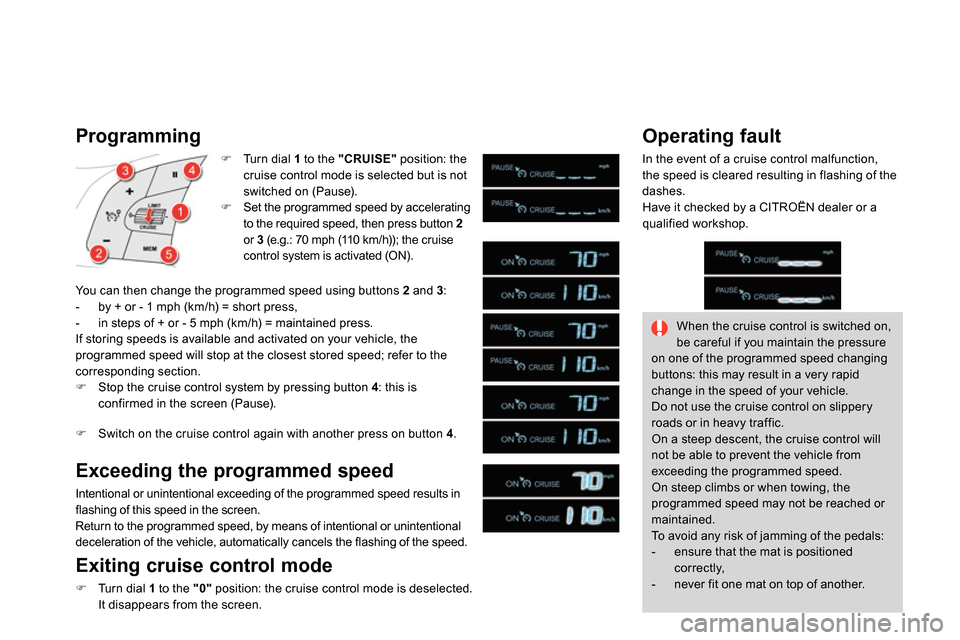
Programming
Turn dial 1
to the "CRUISE"
position: the
cruise control mode is selected but is not
switched on (Pause).
Set the programmed speed by accelerating
to the required speed, then press button 2
or 3
(e.g.: 70 mph (110 km/h)); the cruise
control system is activated (ON).
You can then change the programmed speed using buttons 2
and 3
:
- by + or - 1 mph (km/h) = short press,
- in steps of + or - 5 mph (km/h) = maintained press.
If storing speeds is available and activated on your vehicle, the
programmed speed will stop at the closest stored speed; refer to the
corresponding section.
Stop the cruise control system by pressing button 4
: this is
confirmed in the screen (Pause).
Switch on the cruise control again with another press on button 4
.
Exceeding the programmed speed
Intentional or unintentional exceeding of the programmed speed results in
flashing of this speed in the screen.
Return to the programmed speed, by means of intentional or unintentional
deceleration of the vehicle, automatically cancels the flashing of the speed.
Exiting cruise control mode
Turn dial 1
to the "0"
position: the cruise control mode is deselected.
It disappears from the screen.
Operating fault
In the event of a cruise control malfunction,
the speed is cleared resulting in flashing of the
dashes.
Have it checked by a CITROËN dealer or a
qualified workshop.
When the cruise control is switched on,
be careful if you maintain the pressure
on one of the programmed speed changing
buttons: this may result in a very rapid
change in the speed of your vehicle.
Do not use the cruise control on slippery
roads or in heavy traffic.
On a steep descent, the cruise control will
not be able to prevent the vehicle from
exceeding the programmed speed.
On steep climbs or when towing, the
programmed speed may not be reached or
maintained.
To avoid any risk of jamming of the pedals:
- ensure that the mat is positioned
correctly,
- never fit one mat on top of another.
Page 229 of 400
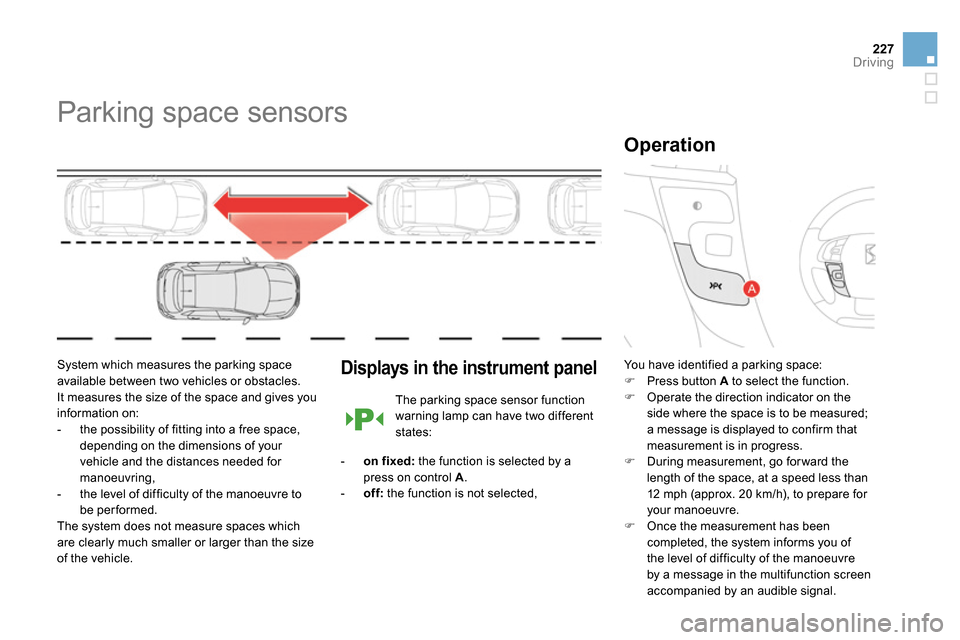
227Driving
Parking space sensors
System which measures the parking space
available between two vehicles or obstacles.
It measures the size of the space and gives you
information on:
- the possibility of fitting into a free space,
depending on the dimensions of your
vehicle and the distances needed for
manoeuvring,
- the level of difficulty of the manoeuvre to
be performed.
The system does not measure spaces which
are clearly much smaller or larger than the size
of the vehicle.
Displays in the instrument panel
You have identified a parking space:
Press button A
to select the function.
Operate the direction indicator on the
side where the space is to be measured;
a message is displayed to confirm that
measurement is in progress.
During measurement, go for ward the
length of the space, at a speed less than
12 mph (approx. 20 km/h), to prepare for
your manoeuvre.
Once the measurement has been
completed, the system informs you of
the level of difficulty of the manoeuvre
by a message in the multifunction screen
accompanied by an audible signal.
Operation
The parking space sensor function
warning lamp can have two different
states:
- on fixed:
the function is selected by a
press on control A
.
- off:
the function is not selected,
Page 230 of 400
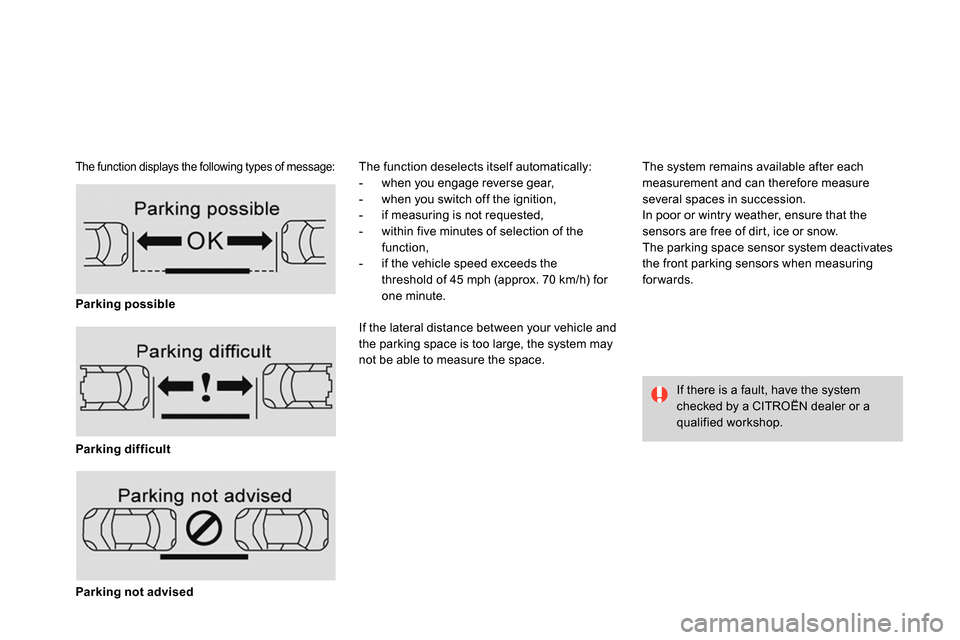
The function displays the following types of message:
The function deselects itself automatically:
- when you engage reverse gear,
- when you switch off the ignition,
- if measuring is not requested,
- within five minutes of selection of the
function,
- if the vehicle speed exceeds the
threshold of 45 mph (approx. 70 km/h) for
one minute.
If the lateral distance between your vehicle and
the parking space is too large, the system may
not be able to measure the space.
The system remains available after each
measurement and can therefore measure
several spaces in succession.
In poor or wintry weather, ensure that the
sensors are free of dirt, ice or snow.
The parking space sensor system deactivates
the front parking sensors when measuring
forwards.
Parking possible
Parking difficult
Parking not advised
If there is a fault, have the system
checked by a CITROËN dealer or a
qualified workshop.